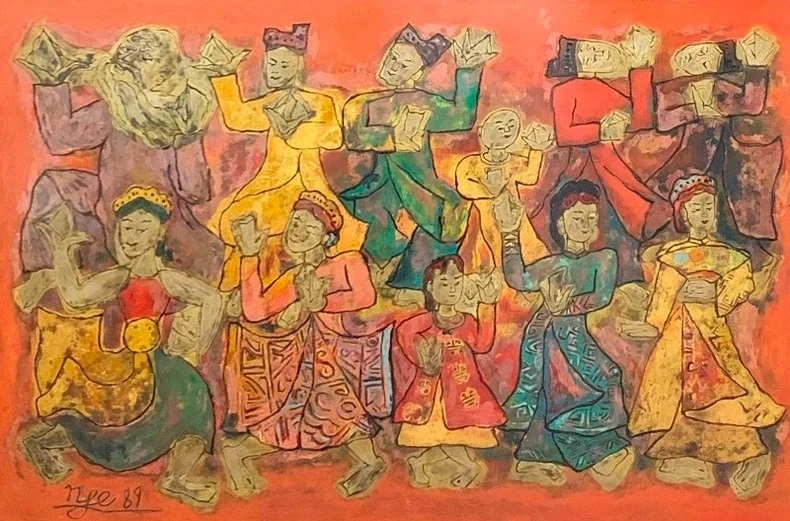Preserving traditional lacquerware or reviving woodblock printing is no longer just a village story, but a quest for the traditional handicraft market in general.

The lacquer painting "Ancient Dance" by renowned artist Nguyen Tu Nghiem. (Photo: Duc Tien)
Growing up with the craft of lacquer painting, as a successor of the forebears from the Ha Thai lacquerware village in Duyen Thai Commune, Thuong Tin District, Ha Noi, artisan Vu Huy Men entered the Ha Noi University of Fine Arts in 1966. Since then, he has continued to work with village artisans to preserve and develop the traditional Ha Thai lacquerware craft. Before 1991, Ha Thai Village’s lacquerware products used only natural lacquer trees (Rhus verniciflua) from Phu Tho Province. After 1991, the products had no market, and cooperatives disbanded. Villagers worked independently and sought markets on their own.
Traditional lacquer is unique for its materials, characterised by a soft texture, deep warm colours and high adhesion that other lacquers cannot replace. However, to complete a lacquerware product or artwork, it is essential to go through elaborate processes, including coating, painting, polishing, and finishing with up to 12 layers of lacquer. Artisans must be persistent in working manually and handle many technical stages over several months. Furthermore, lacquerware artworks have high value and are selective about makers, viewers, and buyers. Customers for natural lacquer products must understand the traditional lacquer techniques. Nowadays, only a few artisans in Ha Thai Village still follow proper natural lacquer techniques.
As a later generation learning and practicing lacquerware, lacquer painter and engraver Dang Cao Cuong, who lives and works in Ha Thai Village, said: “Adapting to the times, contemporary artists use ceramic or composite bases for their works. This new material is lightweight, suitable for large-scale works up to 100 square metres, while wooden materials only accommodate sizes up to 1.4 metres. The production process with new lacquer materials is simplified by a few steps, making it easier. Although it does not offer the warm, deep, and durable colours of traditional lacquer, industrial lacquer has bright, glossy, and eye-catching colours. Whether completing products in traditional or new lacquer forms, Ha Thai villagers share the goal of preserving and developing the craft.”
Similarly, the Thanh Lieu woodblock printing village (in Tan Hưng Ward of Hai Duong City) has been formed and developed over nearly 600 years. Thanh Lieu Village's woodblock products are diverse, ranging from scriptures, poetry, and decorative paintings to seals and ten-object paintings. The Phuc Giang School Woodblocks, recognised by UNESCO as a World Documentary Heritage in the Asia-Pacific region, were carved and printed by artisan Nguyen Huy Vuong from Hong Luc Village (also known as Thanh Lieu Village) in 1758. The village is not only renowned for its exquisite woodblock carving techniques but also for many valuable woodblock prints. Many scriptures printed by artisans from Thanh Lieu Village are preserved in Vinh Nghiem Pagoda and Bo Da Pagoda in Bac Giang Province, and Ba Da Pagoda in Ha Noi.
To create a woodblock, an artisan must go through about 30 steps, including selecting the wood, soaking it, sawing, cutting, planing, flattening, etc., before the carving and printing stages. Over time, the advent of modern printing machinery and technology has led to the decline of the woodblock printing craft. Artisans in the village have shifted to carving judicial seals, tombstones, and other items, leaving only a few households to preserve the traditional craft.
Participating in building the Vietnamese lacquerware brand, artisan Vu Huy Men recognises traditional Vietnamese lacquerware as a special craft that other countries find hard to replicate. Lacquerware artworks have a lifespan of up to hundreds of years. Therefore, it is difficult to practice and train in this craft. The development of the market economy forces artisans to innovate; however, it would be a pity if the traditional lacquerware craft were to fade away. Traditional lacquerware has become "weaker" in its home market, but artisan Vu Huy Men believes that innovation and creativity are always necessary in the profession. The old exists and develops into the new. If Ha Thai could establish a location like the Bat Trang pottery market, the village would surely attract tourists to experience the process, and the value of the lacquerware village would be widely disseminated.
In addition to the story of creativity based on traditional materials and the proper and effective use of heritage without losing cultural identity, the exploitation and utilisation of heritage resources in community development and personal economic development are concerns in traditional craft villages. This endeavour requires many synergistic factors, including the collaboration of the community, the State, and investors to create a market that attracts customers, promotes direct exports, and simultaneously promotes, teaches, and spreads the values of craft villages in contemporary life.
Ngoc Lien - Translated by NDO